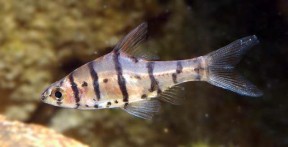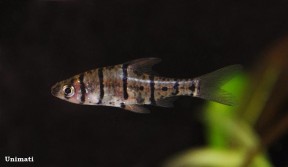Eirmotus octozona
Etymology
Eirmotus: from the Ancient Greek εἱρμός (eirmós), meaning ‘train, continuity’, in reference to the series of sensory pores on the head.
octazona: from the Ancient Greek ὀκτώ (oktṓ), meaning ‘eight’, and ζώνη (zóni), meaning ‘zone’, in reference to the series of eight vertical bars on the body of this species.
Classification
Order: Cypriniformes Family: Cyprinidae
Distribution
The type series consisted of aquarium specimens apparently originated from a lake named Bueng Boraphet in western Thailand, but despite extensive sampling of the region in the years since this species has never been recorded there since.
Specimens used in Tan and Kottelat’s 2008 revision of the genus were obtained from commercial collectors in Johor state, Peninsular Malaysia, and the authors suggest that if E. octozona does occur in Thailand, it is probably restricted to the southern, peninsular section.
Information obtained from a collector in the same study hints that it was once found in areas of peat swamp forest around the town of Ayer Hitam in Johor state, Peninsular Malaysia along with other species of mysterious origin such as Gymnochanda filamentosa. The swamps in this area have been severely disturbed with many of the original habitats destroyed so the current status of many species inhabiting them is best described as unclear.
Records from Borneo probably refer to the congener E. insignis.
Habitat
Unconfirmed. Other members of the genus variously inhabit shady, slow-moving forest streams with dense marginal vegetation, leaf litter or mud substrates and slightly acidic water, and heavily-vegetated swamps (E. insignis), peat swamp forests (E. furvus), or flood plains and the margins of lakes (E. isthmus).
Maximum Standard Length
30 – 36 mm.
Aquarium SizeTop ↑
An aquarium with a base measuring 60 ∗ 30 cm or larger is recommended.
Maintenance
Will thrive in a heavily-planted or forest stream-type set-up, the latter comprising a soft substrate, dim lighting, roots, branches and leaf litter as décor. You could also add aquatic plants that can survive under such conditions such as Microsorum, Taxiphyllum or Cryptocoryne spp. Filtration does not need to be particularly strong as it mostly hails from sluggish waters.
Eirmotus species can be tricky to acclimatise to captive life as they often arrive in poor condition and seem sensitive to fluctuating water chemistry. Never introduce them to biologically-immature aquaria and perform small, regular water changes of around 10% tank volume.
Water Conditions
Temperature: 22 – 26 °C
pH: 5.0 – 7.0
Hardness: 18 – 143 ppm
Diet
Likely to feed on small invertebrates, algae and other zooplankton in nature. In the aquarium it will accept dried foods of a suitable size but should not be fed these exclusively. Daily meals of small live and frozen fare such as Daphnia, Artemia and suchlike will result in optimal colouration and encourage the fish to come into breeding condition.
This species can be quite weak on import and small live foods are highly recommended as an initial diet, introducing the dry and frozen products as the fish become settled. It’s also noted as something of a shy, even reluctant, feeder.
Behaviour and CompatibilityTop ↑
Unsuitable for most community aquaria as it may be intimidated or outcompeted for food by larger or more boisterous tankmates. Small, peaceful cyprinids such as Trigonostigma or Boraras species are suitable companions and we suspect it will also do ok with many small South American characins, Otocinclus or pygmy Corydoras catfishes.
Accommodating it in a biotope-style community of Malaysian species is also a possibility with some of the more suitable ones including Trigonostigma heteromorpha, Boraras maculatus, Brachydanio albolineata, B. kerri, Puntigrus partipentazona, Brevibora dorsiocellata, Trigonopoma gracile, T. pauciperforatum, and Acanthopsoides molobrion plus various Nemacheilus, Pangio, and Homalopteroides spp.
It’s a shoaling species by nature and really should be kept in a group of at least 8-10 specimens. Maintaining it in such numbers will not only make the fish less nervous but result in a more effective, natural-looking display. Males will also display more intense colours and some interesting behaviour as they compete with one other for female attention.
Sexual Dimorphism
Adult males are noticeably slimmer than females and exhibit a pale red colouration in the unpaired fins when in good condition.
Reproduction
Unrecorded as far as we know.
NotesTop ↑
Prior to revision in 2008 the genus Eirmotus was monotypic for almost half a century, with E. octozona the sole representative. There currently exist four species, all of which are similar in appearance.
E. octozona can be told apart from congeners by the following combination of characters: bar 1 present; presence of a large and distinct black mark anterior to anus, visible in lateral and ventral views; simple dorsal-fin rays black, sometimes extending onto first branched ray; other rays hyaline or with diffused chromatophores on last dorsal-fin ray, adjacent to upper extremity of bar 6; 25-31 serrae on last simple dorsal-fin ray; uppermost ray of pectoral-fin with faint black margin; width of bar 5 equal to 1-1½ lateral row scales; mouth terminal, lower jaw wide, rounded anteriorly.
The numbered bars mentioned here refer to the black body bars which the authors ordered from 1 to 8 beginning with the anteriormost across the snout and ending with the small bar across the caudal peduncle. This patterning also gave rise to the english vernacular name of ‘false eight-banded barb’, under which both E. insignis and E. octozona appear to be offered for sale in the ornamental trade.
Members of this genus possess rows of sensory papillae on the snout, cheeks, throat, opercle and interorbital area that are lacking in most other cyprinids but present in a few other genera including Oreichthys, Cyclocheilichthys, Neobarynotus and a handful of other species. They are further characterised by a small adult size of less than 36 mm SL, body patterning consisting of eight dark bars on a red to yellowish background, relatively large scales, an incomplete lateral line with only 2-6 perforated scales, serrations on the last simple dorsal ray and a lack of barbels.
References
- Schultz, L. P., 1959 - Tropical Fish Hobbyist 7(9): 9-11, 36-37
A new cyprinid fish from Siam. - Kottelat, M., 2013 - Raffles Bulletin of Zoology Supplement 27: 1-663
The fishes of the inland waters of southeast Asia: a catalogue and core bibiography of the fishes known to occur in freshwaters, mangroves and estuaries. - Tan, H.H. and M. Kottelat, 2008 - Raffles Bulletin of Zoology 56(2): 423-433
Revision of the cyprinid fish genus Eirmotus, with description of three new species from Sumatra and Borneo.





